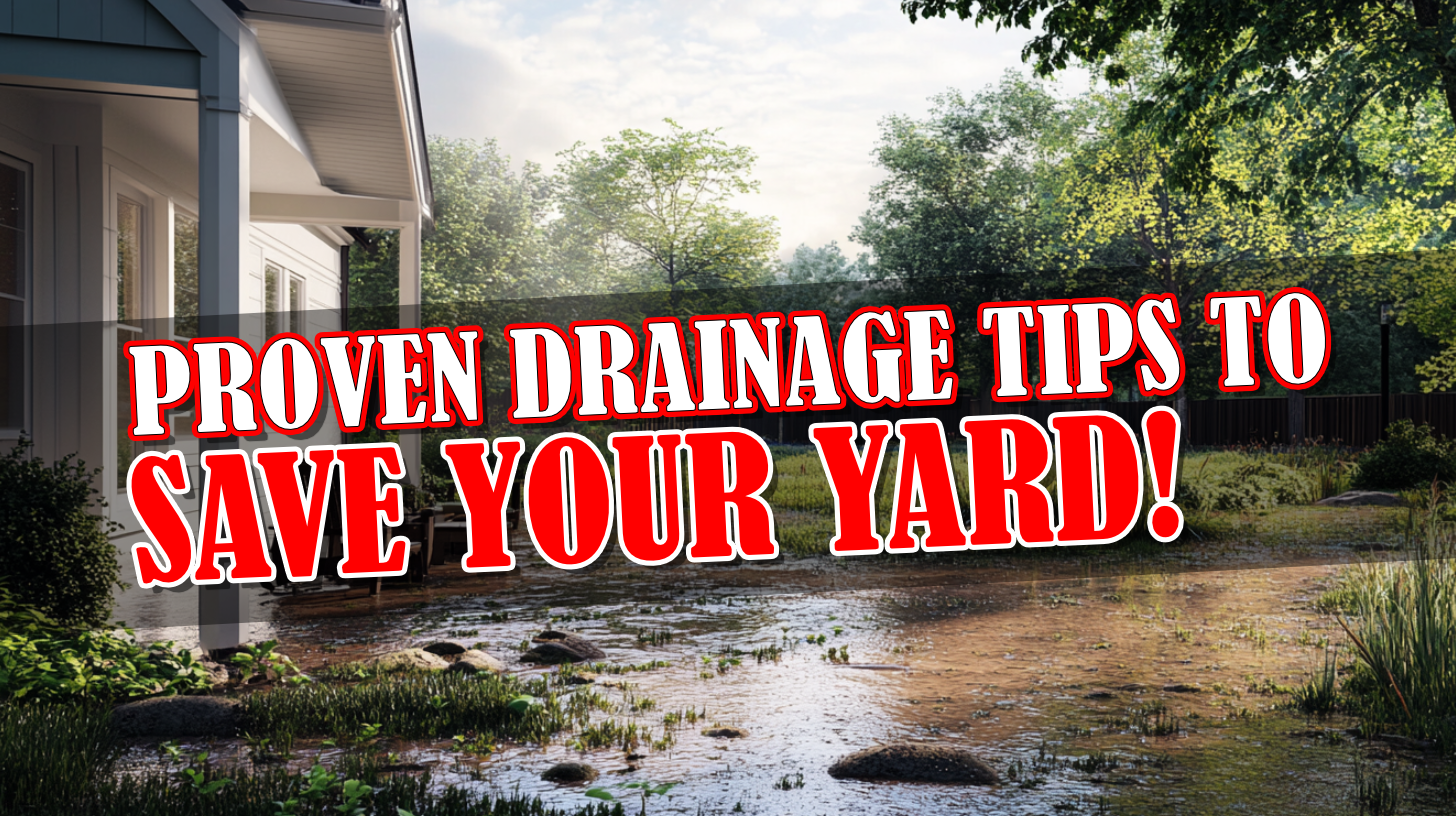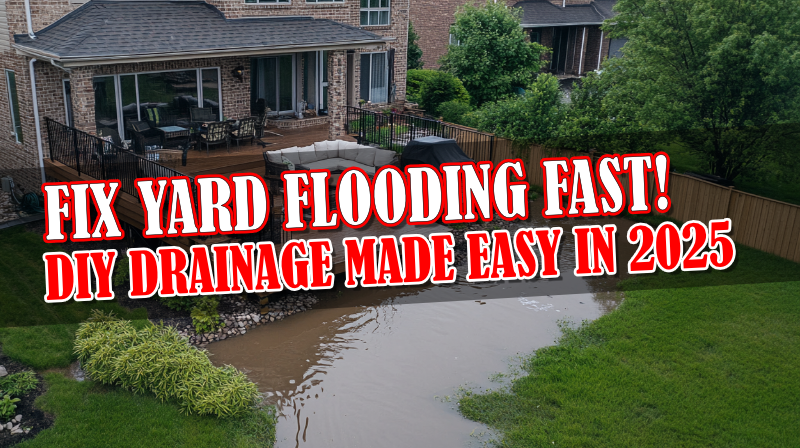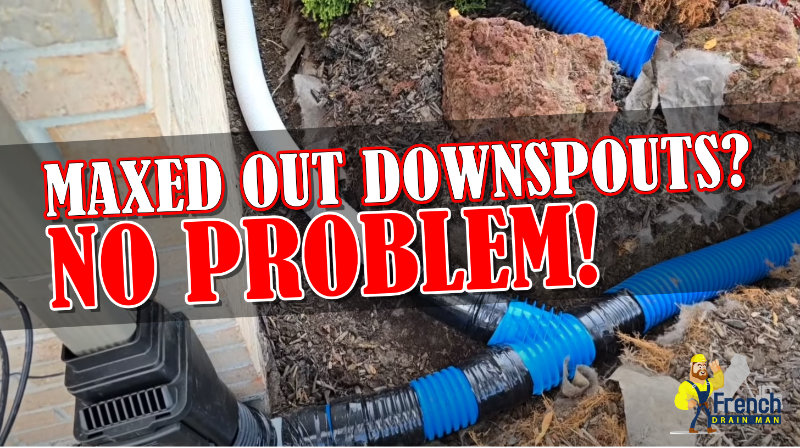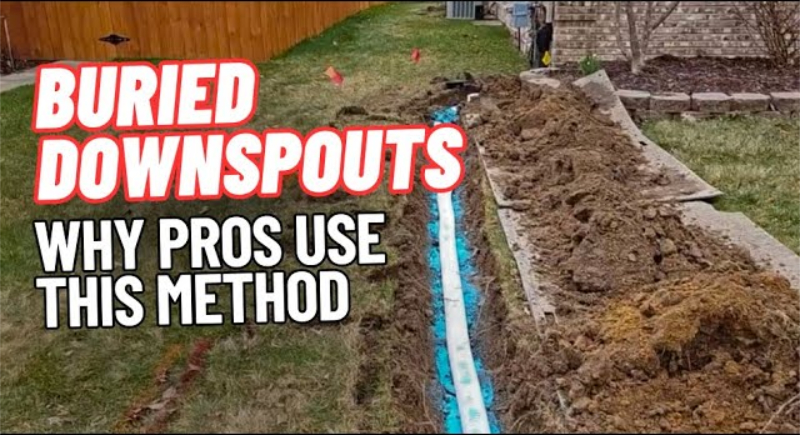How To Build a French Drain That Lasts Forever
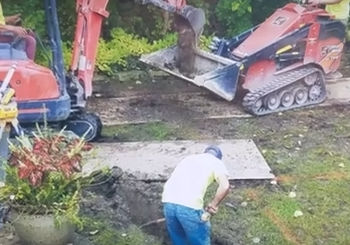 Welcome to the French Drain Man YouTube channel. We’re going to go over some do’s and don’ts for French drains. I’m going to show you some of our competitor’s systems that failed and we had to replace them. And I’ll show you how to build a French drain that lasts forever. Let’s begin.
Welcome to the French Drain Man YouTube channel. We’re going to go over some do’s and don’ts for French drains. I’m going to show you some of our competitor’s systems that failed and we had to replace them. And I’ll show you how to build a French drain that lasts forever. Let’s begin.
Here’s a failed French drain that we did not install. None of our systems fail. The stone gravel French drain will last forever. A French drain that’s installed correctly will last forever, simply put. What happened here is they didn’t use a geotextile fabric to separate the stone from the subsoil. So you can see the stone in subsoil migrated into one another. You can see that the pipe is just plugged. The inside of that pipe is not plugged. It’s plugged externally. The water can’t get through all the clay and stone mixed since they didn’t use a filter fabric. You need to use a non-woven geotextile filter fabric. We’ll get into that in a little bit here. So there again, you can see that that is a real shallow pipe. We just cut the sod off. The pipe was pushed up to the surface. The frost will do that in Michigan in any place in the north where you have a real winter.
Here’s another failed system. We did not install this. I want to keep emphasizing that I’m showing you pictures of failure. These are things that we run into out in the field. This pipe was just a pipe that we abandoned because we went in, and put a system in that would last forever. This pipe has a filter fabric on it. We don’t endorse that for a French drain, a yard drain. I’ll go over that detail. You can see they used a larger stone aggregate, which I like, but they didn’t use a geotextile non-woven fabric, so the stone migrated into the subsoil. The subsoil migrated into stone and you can’t get water through that. It’s plugged. So the pipe wasn’t plugged. You can see some dirt that’s pushed in it from the backhoe or excavator, but the pipe was not plugged. You just couldn’t get water to the pipe. That’s the problem. It’s because of how they installed it.
So here’s another, we see this a lot. This is a corrugated drainpipe and they wrapped it with drainage fabric. You don’t want to do this either. This is another bad idea and it just results in failure. These systems only work if you can get the water to the pipe and the way we build them with so much stone, the water will move through the gravel.
This was another failed pipe and it just went to a pop-up and then the water was supposed to define gravity and go up into the storm drain catch basin, which that don’t work. So we core drilled here and then we ditched out a really big trench and I’ll show you how we go about building our French drain systems.
We use an excavator or backhoe and you can see the gentlemen down in the trench, we’re ditching out a really nice French drain trench here. We’re taking all that dirt out. Notice how there are not piles of dirt. There are not piles of dirt anywhere on this job site. As soon as the shovel gets a scoop of the heavy soil, he’s putting it in a mini loader and we’re getting it off-site.
Here’s another example. You can see we have a spotter in the trench. He’s looking for sprinkler pipes and he’s also taken topol readings with a laser level. He’s got a transit onsite on a tripod and he’s communicating with the operator. Now, look how clean that is. We’re taking all the dirt that we’re scooping out of this trench. We’re putting it in this mini-loader and we’re carrying it out to the front to dump trucks.
Now compare these other methods, they bring in a trencher and look at the damage they do. Look at the damage to that turf. Now, not only most trenchers are only gonna make a six-inch groove. That’s not ditching a job. You need to ditch a job for a good French drain. I do know that they make big commercial trenchers that will go wider than six inches. I’m well aware. However, I want to restore the homeowner’s yard. I don’t want to destroy it. I want to go in and be as noninvasive as possible. That’s, that’s the goal here.
So not only does a trencher cut through sprinkler lines and you gotta deal with that later and disturb your turf and it takes a while to mend turf. So it’s an eyesore for a few months. So here’s a trencher versus an excavator. You got a nice deep groove, nice clean job. We put the plywood down so we don’t disturb the turf at all so we can get the machinery in and out of there. All our machines are on tracks, not rubber tires. That’s important.
So a lot of people ask what’s the difference between a curtain French drain and a perimeter French drain and these pictures here will help you out a lot. We were able to get these pictures when the leaves finally fell off the trees. It’s late season right now. That’s a perimeter French drain because it follows the fence, the property line.
Now a curtain French drain would be around the house, so it’d be uptight to the house and go around the house. That’s a curtain French drain. So the way you build them is the same, it’s just when people refer to a curtain drain, they’re referring to going around the building. When they’re referring to a perimeter French drain, they’re referring to going around the property. So perimeter French drain will catch all your neighbor’s water that’s coming into your property, which is a problem for a lot of people. This makes for happier neighbors right here. Just put it in a French drain and then also all your own water that runs to the back of the lot and we take it either to a waterway or storm drain catch basin, whatever there is, we’ll get the water out of there.
Another great shot of just how neat and clean you don’t see a big pile of dirt anywhere. We take all the dirt out. You don’t want to put any of the dirt back in. That’s key here. You don’t want to put any of the dirt back in. You want to put all stone in. Now you can hardly see it, but here’s the turf. We cut the turf off with two and a half inches of root and just laid it to the side. That’ll go back in over the system. I’ll show you that later, but look at a trenching method. Look at how much damage it’s doing. What a mess it’s making, and then instead of taking away all the dirt, they’re just going to put in a little bit of stone over a pipe and pushed it dirt over top of it.
Now, if you have poor percolating soil, putting that same soil back in is just going to plug the system. Now the homeowner will think that it works initially because there are so much air pockets. Look at all the air pockets and that dirt freshly turned up like that. It’ll take a while before it’s compacted so the contractor could actually make away. We call it a cash grab when they come in and they built systems like this. It’s unfortunate too. Now I ended up having to replace these systems all the time, but once this soil settles and it becomes compacted and there are no more air pockets for the water to find its way to the little bit of stone they do put in. These things quit working, so we put a big, as you can tell us, a really big channel, real big trench.
Here’s another example of how neat and clean we are. You don’t see a big dirt pile to the left or to the right. Here’s the sod. You can barely see it laying over the side. Nice bluegrass here in Michigan, where we are located.
Now, that’s a non-woven geotextile fabric. That’s what you want to use. That’s a soil separator. It’s like a felt, water runs right through it. It separates the stone from the subsoil so you don’t get that mix that I showed you. Real quick, I’ll just go back to that opening shot. They didn’t use a non-woven geotextile fabric to burrito wrap the stone and pipe as one. So that’s how you end up with failure. And when you go ahead and use a pipe with a filter wrap on it. Well, now you’re not wrapping the stone so the stone migrates in the subsoil. The subsoil migrates into stone and the system quits. So what good is it? It’s not helping. If you have a pipe that’s not plugged and you can’t get the water to it, the system still not going to work. So I understand the theory behind it and I see how some people get tricked by it, but don’t. You want to wrap the entire system to stone and pipe as one.
Now with going under sidewalks or driveways, you gotta bore and you gotta use schedule 40. That’s what you want to do when you’re going under concrete, so here you can see we did a bore and we’re putting a couple of couplings together so that the corrugated pipe will snap right on the schedule 40. Here’s another one showing the guys working on the connection points of the schedule 40 that’s underneath the sidewalk.
This is six inch. How do you get six-inch under a four-inch slab of concrete when you don’t have very much fall to the street without leaving a belly and this big pocket of water? We’ll go to a Y with some six to four reducers and you go to two four-inch pipes. That’s how you get a six-inch pipe under a sidewalk without leaving a belly and making a mess and having a system that works properly. A six-inch pipe usually come in place when you have 200 feet or more upstream, so keep that in mind and that’s just a generic number to work with. There’s so much involved as far as the math of the area, of the yard, rooftops, all that is figured in everything that we design.
Okay, so I’m not bashing The Home Depot. I love the place. You know, I’m like any guy, I’m a junkie for tools. I love the place, but there’s a place for this kind of pipe and there’s a type of soil for this kind of pipe and it fits in the agricultural community on certain farms just fine. I don’t like this pipe, I don’t use it for my systems. I’ll show you what I use. Look how big those inlets are. We use a large aggregate, not a pea stone, we use a really large aggregate so we can get away with a big opening like that. You can fit a US quarter in that. Again, you know, this is what you get at the big box stores.
The inlet that we have in our pipe, we are going to evacuate water so fast. That’s what people want. Nobody’s got any patience anymore and I understand that. That’s fine. We’ll build you a system that screams. We’ll build you a system that moves water.
Now another commonly asked question, my sprinkler system. How do you deal with that? Well, we go under it. We go under all the sprinkler lines and you can see how we were very careful. We actually cut the sprinkler line and then put in couplers. You can’t see the connections because they’re on the other side of the non-woven geotextile filter fabric.
Alright, so now we got our non-woven geotextile filter fabric and we got our pipe at the bottom of the trench. Yes, we do put our pipe at the bottom of the trench. I know that some people instruct you to put a few inches underneath the pipe. For a back yard drainage system in Michigan, you don’t want to do that. As long as you’re using a geotextile non-woven filter fabric where the water just runs through it and you’re separating the soil from your system, you can lay your pipe right on the filter fabric, the non-woven geotextile filter fabric. You want to lay that pipe right on it. That way the frost can’t heave this pipe to the surface.
Here’s a bigger system. You can see there’s two, four-inch corrugated pipes in that system. At the bottom, you can see the non-woven geotextile filter fabric. Going back to these failed systems, they didn’t wrap the stone with the pipe. They just put a wrap around the pipe. That’s why it failed. These always fail. That’s how you want to do it. Wrap your stone and your pipe as one. This black non-woven geotextile filter fabric. That’s what you want to do.
This is a backyard where the swale went down the center of it, so water would always lay in here. You could always tell when somebody had a water problem for years. This was a situation where they had a water problem for the past decade and finally found us and we helped them out with it. How you can tell, we have beautiful bluegrass here in Michigan, so when you see grass like that, that means there’s low oxygen. That means saturated soils and it chokes out the bluegrasses and these undesired grasses can actually grow in those conditions and that’s what you end up with. So when we finished the system, they went ahead and hired a company to come in and cut out and remove all that turf and put in some new bluegrass.
Here’s a great shot showing you just how thick the sod is that we cut out. We take two and a half inches of roots, you can see those slabs of turf, nice bluegrass. You can see the large aggregate that we’re pouring into our French drain system. This one is running out to the street and this one did go under the walk.
Nice and clean. We take the non-woven fabric, you can see a staple. We staple it. Done. It’s wrapped. It’s a burrito wrap, it’s what we call it in the industry, the building industry. So the stone and pipe are wrapped as one. There’s one more piece of sod that goes in. These pieces have already been set in place. So tell me, would you rather have this or would you rather have this? This system here is 18 inches. Everything’s specked out to handle the task at hand. So people always ask, how wide and how deep? They all vary, it depends on the application. So here you see our system’s pretty wide, 18-inches wide. I know this system happened to go, this particular one, went 24 inches deep.
So what is with the duct tape? I’m digging up these systems and having to replace them. I’m going to help you guys out with that, show you the right tape. You want to use a PVC tape. It’s known as a tile tape. It’s PVC and it’s super, super stretchy, super sticky. Look at that. Look at that. You can see it’s watertight. You can see how it forms right to the shape of the pipe. The manufacturer says this material is gonna end up lasting 200 to 500 years. Don’t use duct tape, don’t use silicone. Use tile tape, please use tile tape by all means. So we get a lot of calls. Where do you buy this? I have over 200 suppliers. Been in business for more than 30 years now. So I’m gonna help you guys out with the tile tape. That’s the company that we buy our tile tape from. There are different tile tapes out there, but this is super, super sticky. Alright, so there’s the US number for you, and if you’re not in the US, there’s the outside of the United States phone number for you. Buy tile tape. Super Sticky, super stretchy, last for 200 to 500 years, and it’s guaranteed for 100 years. I know the warranty on it.
So I hoped this answers some of your questions. I hope that this helped educate the homeowners and the DIY guy, and if you’re looking for this service and in southeastern Michigan, we service northern Macomb County, Michigan, northern Oakland County, Michigan, give us a call at 248-505-3065.





